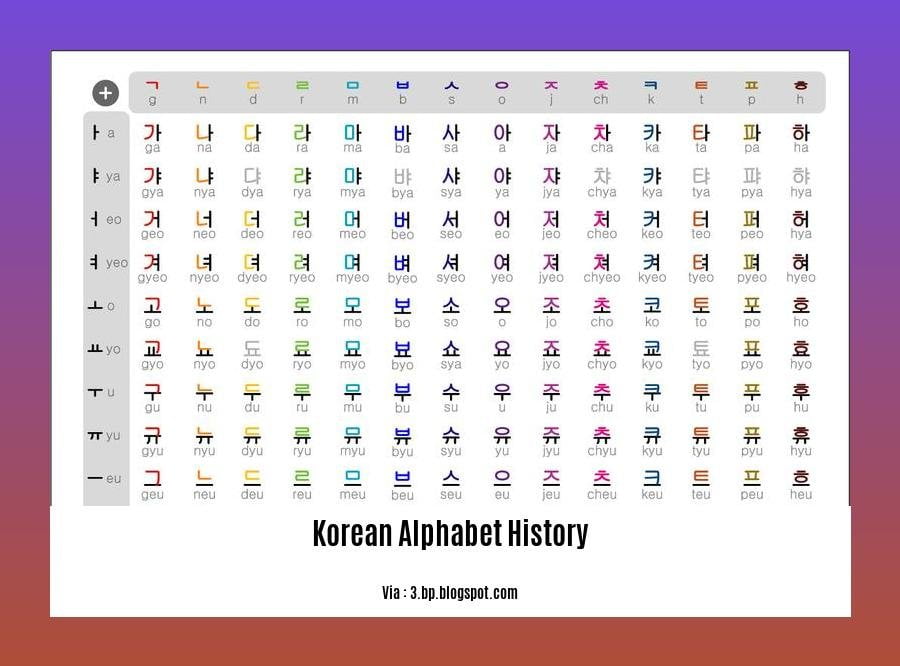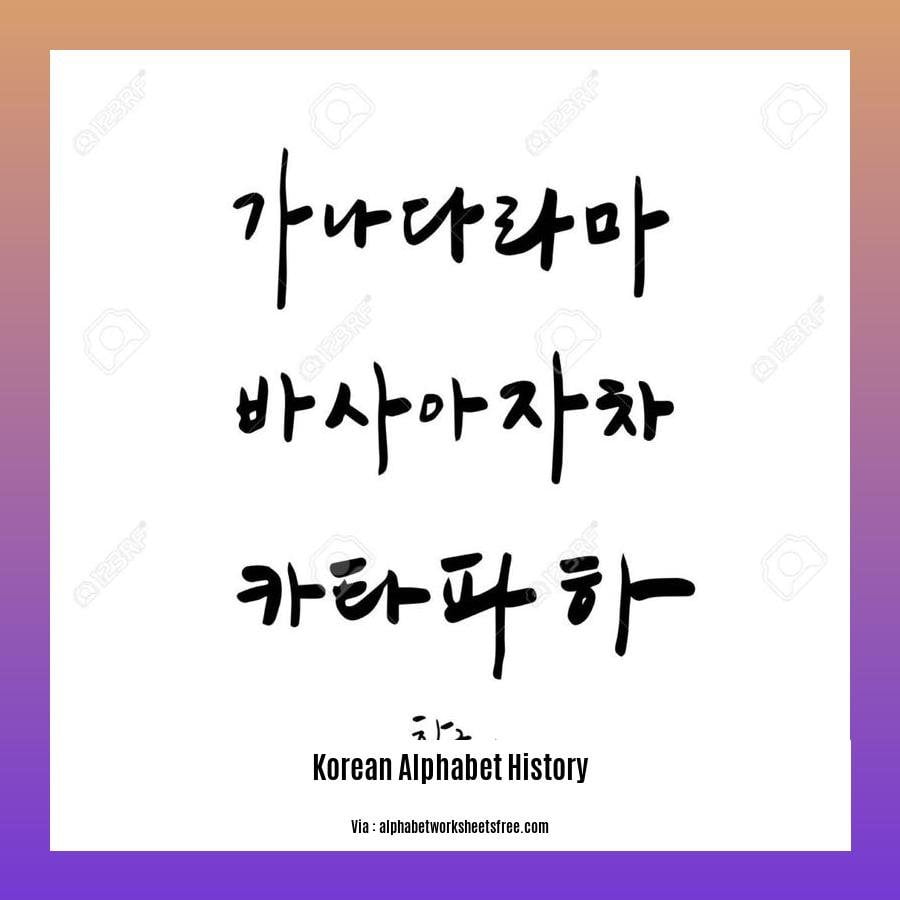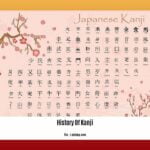Embark on a journey through time as we unveil the profound legacy of Hangul, the Korean alphabet. In this exploration, we will delve into the unique origins, structural features, and the immense cultural impact of this remarkable writing system. Hangul’s creation in the 15th century marked a pivotal moment in Korean history, forever transforming the nation’s linguistic landscape. Join us as we uncover the fascinating story of Hangul, a testament to human ingenuity and a symbol of Korean identity.
Key Takeaways:
– Hangul, the Korean alphabet, was created in 1446 by King Sejong the Great to enhance literacy and education among Koreans.
-
It replaced the previously used Chinese characters (Hanja) and became the primary writing system in Korea.
-
Hangul consists of 24 letters, 14 consonants, and 10 vowels, and is arranged in blocks, with each block representing a syllable.
-
As a phonetic alphabet, each letter represents a specific sound, and as a syllabary, each block represents a syllable.
-
Hangul’s creation facilitated the development of Korean literature, culture, and identity and is still used in all aspects of life in Korea.
Korean Alphabet History: A Journey Through the Legacy of Hangul


In the realm of written languages, Hangul—the Korean alphabet—stands as an exceptional creation. Birthed in 1446 under the reign of King Sejong the Great, this ingenious system revolutionized communication in Korea, leaving an indelible mark on its history and culture. Join us as we embark on a journey through the rich tapestry of the Korean alphabet history, uncovering its origins, structure, and profound cultural significance.
The Genesis of Hangul: A Quest for Linguistic Independence
Prior to Hangul’s inception, Koreans primarily relied on Chinese characters, known as Hanja, for written communication. However, these characters, numbering in the thousands, posed a significant challenge to literacy, particularly among the common populace. Recognizing this impediment, King Sejong embarked on a mission to develop a writing system that would be both simple and accessible to all Koreans.
Ingenious Design: Simplicity and Efficiency in Harmony
Hangul’s design reflects a remarkable balance of simplicity and efficiency. Consisting of 24 letters—14 consonants and 10 vowels—this phonetic alphabet is remarkably easy to learn and use. Each letter represents a specific sound, and the characters are arranged in blocks that correspond to syllables. This innovative approach enabled widespread literacy and facilitated the dissemination of knowledge across all societal strata.
A Watershed Moment: Hangul’s Impact on Korean Society
The introduction of Hangul marked a pivotal moment in Korean history. Prior to its creation, literacy was largely confined to the elite, who had the time and resources to master Hanja. Hangul’s simplicity, however, opened the doors of education to the masses, empowering ordinary Koreans to read, write, and express themselves in their native language. This surge in literacy had a profound impact on Korean society, fostering a vibrant literary tradition and contributing to the development of a distinct national identity.
A Legacy of Literacy and Cultural Expression
To this day, Hangul remains the official writing system of Korea, serving as the bedrock of its vibrant literary, academic, and cultural landscape. From novels, poetry, and scholarly works to government documents and everyday communication, Hangul is an integral part of Korean life. Its creation stands as a testament to the ingenuity and foresight of King Sejong and the enduring power of language to shape and transform societies.
Hangul: A Source of National Pride and Global Recognition
Hangul is not merely a writing system; it is a symbol of Korean identity, a source of national pride, and an object of global admiration. Its unique structure and historical significance have earned it international acclaim, with UNESCO recognizing it as a World Heritage in 2017. Hangul’s legacy extends beyond Korea’s borders, inspiring other languages and writing systems around the world.
Conclusion: Hangul’s Enduring Legacy
Hangul’s creation was not just a linguistic achievement; it was a social and cultural revolution that empowered a nation and transformed its destiny. From its humble beginnings as a phonetic writing system to its status as a global symbol of linguistic innovation, Hangul has left an indelible mark on Korean history and culture. As we reflect on its remarkable journey, we are reminded of the enduring power of language to foster literacy, empower individuals, and shape the course of nations.
For a fascinating journey into India’s rich past, explore the literary sources of medieval Indian history and delve into the essence of its glorious heritage. Ace your revision for the O-level history exam with our comprehensive guide to 14-mark questions and answers that will leave you feeling confident and prepared.
The Korean Alphabet: A Historical Legacy in English
Delving into the depths of the Korean alphabet, Hangul, is like embarking on a captivating journey through history. Join us as we unveil the fascinating story of this remarkable writing system, its profound impact on Korean society, and its enduring legacy in the global tapestry of languages.
Key Takeaways:
-
Hangul was created by King Sejong the Great in 1443 as a simpler and more efficient writing system for Korean.
-
Designed with the principle of “KISS” (Keep It Simple Stupid), it was intended to be easy to learn and reflective of Korean grammar.
-
Hangul revolutionized the expression of Korean pronunciation, unlike previous methods like Hanja (Chinese characters).
-
The Hunminjeongeum, a manual for Hangul, was published in 1446, marking its official introduction to the Korean people.
-
Hangul’s creation had a profound impact, increasing literacy rates and promoting education and communication accessibility.
-
Hangul consists of 24 letters, comprising 14 consonants and 10 vowels, which combine to form syllables.
-
Its unique design reflects the shapes of the mouth and tongue when pronouncing sounds, making it intuitive to remember.
-
Hangul is the official writing system of both North and South Korea, used in all forms of written communication and taught in schools.
-
UNESCO recognized Hangul in 1997 as one of the world’s outstanding writing systems, praising its scientific design and effectiveness.
Hangul’s creation was a visionary act that transformed the Korean language and society. It was a deliberate effort to create a writing system that was uniquely Korean, reflecting the language’s unique sounds and grammar.
Sources:
What to Do in Korea: A Brief History of Hangeul
FAQ
Q1: What inspired King Sejong to create Hangul?
A1: King Sejong, the 4th ruler of the Joseon dynasty, was motivated by the desire to create a writing system that was simpler, more efficient, and better suited to the Korean language than the existing Chinese characters (Hanja). His goal was to increase literacy and education among the Korean population.
Q2: How does Hangul’s structure reflect the Korean language?
A2: Hangul’s structure is unique in that it represents the sounds of the Korean language. Each letter represents a specific sound, and syllables are formed by combining these letters. This allows Hangul to accurately represent the Korean pronunciation, unlike previous writing systems like Hanja that were not designed for Korean phonology.
Q3: What impact did the creation of Hangul have on Korean society?
A3: The creation of Hangul had a profound impact on Korean society. It led to increased literacy rates, making education and communication more accessible to the general population. Hangul also helped to establish a distinct Korean identity and language, separate from Chinese influence. It became a symbol of national pride and cultural heritage for the Korean people.
Q4: What are some of the unique features of Hangul?
A4: One of the unique features of Hangul is the way its letters are designed. The shapes of the consonants are based on the shapes of the mouth and tongue when pronouncing those sounds, making them intuitive to remember. Hangul is also a syllabary, meaning that each block represents a syllable rather than a single sound. This makes it a more efficient writing system compared to alphabets that use separate letters for each sound.
Q5: How is Hangul used today?
A5: Hangul is the official writing system of both North and South Korea and is used for all forms of written communication, including books, newspapers, and official documents. It is also taught as a compulsory subject in schools in both countries. Hangul is widely recognized for its scientific design and effectiveness in representing the Korean language, and in 1997, UNESCO recognized it as one of the world’s most outstanding writing systems.
- Unveiling Bernhard Caesar Einstein’s Scientific Achievements: A Legacy in Engineering - July 15, 2025
- Uncover who is Jerry McSorley: CEO, Family Man, Business Success Story - July 15, 2025
- Discover Bernhard Caesar Einstein’s Scientific Contributions: Unveiling a Legacy Beyond Einstein - July 15, 2025






![[HISTORY OF WHOO SINGAPORE] Unveiling the Secrets of Ancient Korean Court Beauty Rituals history-of-whoo-singapore_2](https://www.lolaapp.com/wp-content/uploads/2023/12/history-of-whoo-singapore_2-150x150.jpg)








